The pearlscale goldfish, known as chinshurin in Japanese, is a popular ornamental freshwater fish prized for its unique appearance and gentle demeanor. This fish is a variety of the common goldfish (Carassius auratus auratus) and is distinguished by its distinctive scales, which resemble pearls and give it an eye-catching, rounded look.
Pearlscale goldfish are often found in home aquariums due to their vibrant colors and engaging personalities. They thrive in well-maintained tanks that mimic their natural habitats, which are typically slow-moving waters with ample vegetation. Providing adequate space and filtration is essential for their health, as these fish can grow quite large.
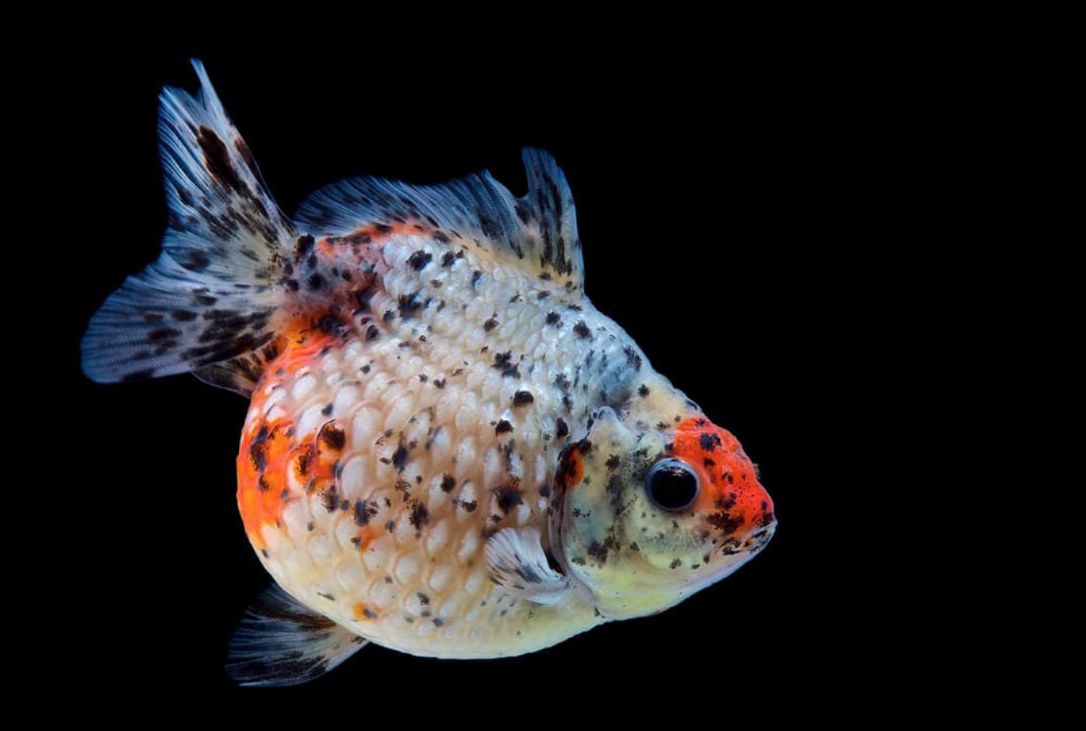
Contents
Habitat in the wild
The pearlscale goldfish is a captivating type of fancy goldfish belonging to the family Cyprinidae, renowned for its distinctive features, such as a spherical body shape, numerous dorsal fin rays, and its signature pearly scales. These ornamental fish have been selectively bred to enhance their unique appearance, making them a favorite among aquarists.
The Cyprinidae family, commonly referred to as the carp family, is one of the largest families of freshwater fish, encompassing a wide variety of species. Notable members include common carp, koi carp, rosy barb, and cherry barb. All fancy goldfish, including the pearlscale, trace their lineage back to wild carp, which were first domesticated in ancient China over a thousand years ago. Through generations of careful selective breeding, various goldfish varieties, including pearlscale, were developed.
While the precise origin of the pearlscale goldfish remains unclear, it is believed to have emerged in China or Japan during the 19th or early 20th century. Fish breeders in these countries have historically played a significant role in advancing goldfish varieties, contributing to the development of many fanciful forms that we cherish today.
The popularity of pearlscale goldfish has surged among hobbyists worldwide, thanks to their unique aesthetics and gentle disposition. As with other fancy goldfish, selective breeding continues to enhance the pearlscale variety, resulting in a broad spectrum of color patterns, including vibrant reds, oranges, and even calico variations.
Today, pearlscale goldfish are commonly found in aquariums and ponds around the globe, celebrated for their beauty and charm. Their rich history and ongoing evolution highlight the passion and dedication of fish breeders committed to preserving and enhancing these stunning aquatic companions.
Description
Lifespan
The lifespan of pearlscale goldfish can vary significantly depending on the care they receive and their living conditions. On average, these fish can live for around 10 to 15 years in captivity. With optimal care, including a balanced diet and stable water conditions, some individuals have been known to thrive for 20 years or more, making them a rewarding long-term commitment for aquarists.
Size
Pearlscale goldfish typically grow to be about 5 to 6 inches (12 to 15 centimeters) in length when kept in a well-maintained aquarium or pond. Factors such as genetics, diet, and environmental conditions can influence their growth, with some individuals potentially reaching slightly larger sizes. Proper tank size is crucial, as a spacious environment promotes healthy growth.
Body Structure
The pearlscale goldfish has a distinctive short, rounded, oviform body, similar to that of a fantail fish. All of its fins are short, contributing to its compact appearance. A defining feature is the separate, large gibbose scales that resemble halved pearls stuck to its body. If a pearlscale loses a pearl-like scale, a new one will eventually grow back; however, it will have a standard shape and lack the unique appearance of the original.
Color Variations
The body color of pearlscale goldfish is often orange, red, or white, with the orange-red variety being the most sought after. Some fish may exhibit blurred spots, especially in yellow variations combined with darker colors. Recently, black and calico pearlscale goldfish have become popular, showcasing diverse and striking patterns that attract collectors.
Health Considerations
Regular health monitoring is essential, as pearlscale goldfish can be susceptible to diseases such as fin rot or ich. Keeping the tank clean and maintaining stable water parameters can prevent these issues. It’s advisable to perform regular water changes and use a good filtration system to ensure a healthy environment.
| Characteristic | Description |
|---|---|
| Body Shape | Spherical or egg-shaped body |
| Scale Type | Pom-pom or pearl-like raised scales |
| Coloration | Various colors and patterns, including metallic shades |
| Size | Typically grows to about 5-6 inches (12-15 cm) in length |
| Dorsal Fin | Prominent and long dorsal fin |
| Tail Fin | Double-tail or fan-shaped tail fin |
| Anal Fin | Single anal fin |
| Pectoral and Pelvic Fins | Paired fins on the sides and bottom of the body |
| Eyes | Protruding and large eyes |
| Behavior | Generally peaceful and sociable |
| Lifespan | Can live up to 10-20 years with proper care |
| Diet | Omnivorous; prefers a balanced diet with pellets and veggies |
| Tank Requirements | Need a well-maintained tank with proper filtration |
| Water Parameters | Temperature: 65-75°F (18-24°C); pH: 6.5-8.0 |
| Tank Size | Minimum 20 gallons for one adult pearlscale |
| Breeding | Egg layers, require a separate breeding tank and special conditions |
| Special Considerations | Sensitive to poor water quality and overcrowding |
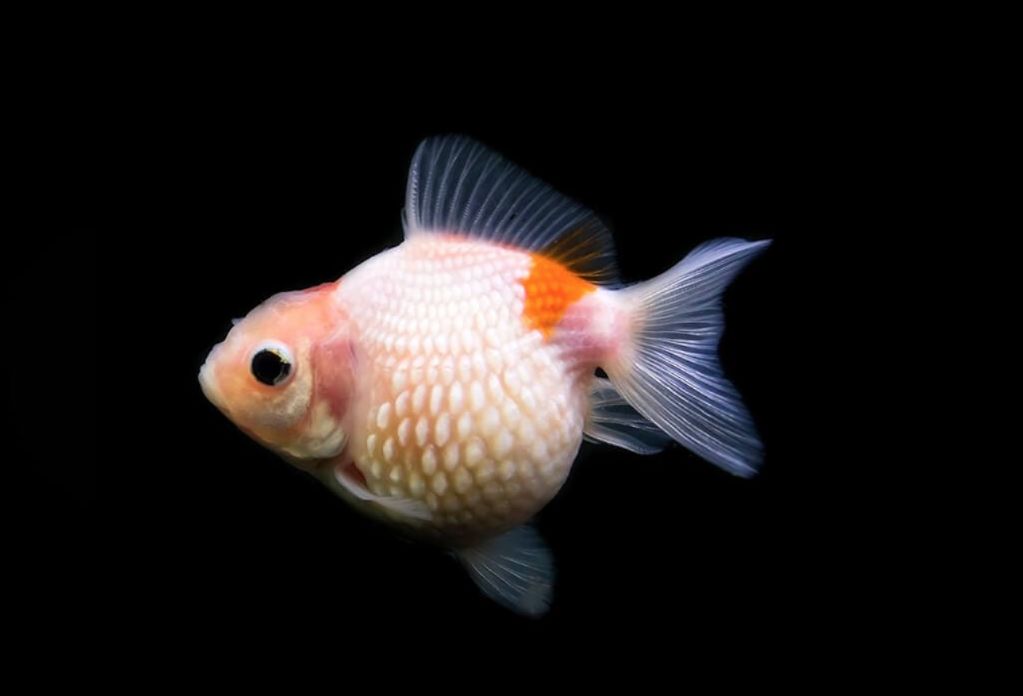
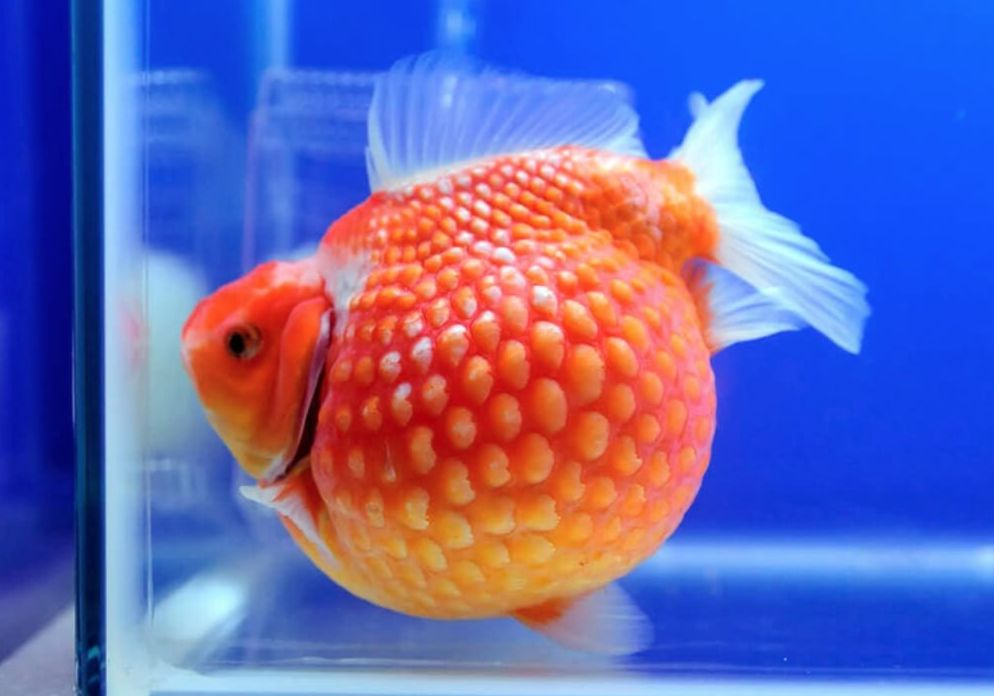
Difficulties in keeping
Pearlscale goldfish are generally considered hardy fish, similar to other goldfish species. Their ancestry traces back to common carp, which are well adapted to cold-water environments and are not particularly demanding in terms of care. This lineage contributes to their resilience.
Care and keeping in a tank
Tank Size
The appropriate tank size for pearlscale goldfish largely depends on the number of fish and their expected growth. Like other fancy goldfish varieties, pearlscale goldfish require more space compared to common goldfish due to their rounded body shape and potentially shorter swimming abilities. As a general rule of thumb, it is recommended to have at least 20 gallons (75 liters) of water per adult pearlscale goldfish. However, larger tanks are always preferable, as they provide more swimming space and help maintain better water quality.
For a single adult pearlscale, a tank size of 20 to 30 gallons (75 to 113 liters) is ideal. If you plan to keep multiple pearlscale goldfish, it’s crucial to increase the tank size accordingly to accommodate their needs. Since these goldfish can grow to around 5 to 6 inches (12 to 15 cm) in length, a spacious environment is essential for their well-being. Overcrowding can lead to stress, poor water quality, and health issues, so it’s vital to plan ahead and invest in an adequately sized tank.
Substrate
Pearlscale goldfish enjoy digging in the tank substrate, making it advisable to use pebbles or large-grained sand. This type of substrate minimizes scattering, allowing for easier maintenance. Some aquarists prefer a bare-bottom tank for simpler cleaning and to prevent the risk of ingestion, which can lead to digestive issues. When selecting a substrate, avoid sharp or small particles that could harm the fish or be ingested, as pearlscale goldfish are bottom feeders and may accidentally consume debris while foraging for food.
Tank Decor
When it comes to tank decor, both artificial and live plants can be used. Live plants with strong roots and coarse leaves, such as anubias, are ideal since they won’t be eaten by the fish and contribute to a healthy ecological environment. However, pearlscale goldfish can damage plants with soft leaves, and detritus from their waste can accumulate on them, requiring frequent cleaning. Additionally, any tank decorations, including stones and driftwood, should be smooth and free of sharp edges to prevent injury to the fish. It’s essential to leave some open swimming space in the tank to promote healthy activity and comfort.
Tank Lighting
While not strictly necessary, lighting can enhance the appearance of pearlscale goldfish, allowing their colors to shine. Soft, ambient lighting can create a pleasant viewing environment and encourage more active behavior.
Water Parameters
Maintaining proper water parameters is critical for the health of pearlscale goldfish:
- Temperature: The ideal temperature range is between 65°F to 75°F (18°C to 24°C). It’s vital to avoid rapid fluctuations to prevent stress.
- pH Level: Aim for a stable pH of 6.5 to 8.0. While pearlscale goldfish can tolerate a wider pH range, stability is key to preventing health issues.
- Ammonia and Nitrite: Both should be maintained at 0 ppm, as they are highly toxic. Regular water changes and effective filtration are essential for controlling these levels.
- Nitrate: Keep nitrate levels below 40 ppm. While less harmful than ammonia and nitrite, high nitrate levels can still negatively affect fish health.
- Hardness: A range of 5 to 20 dGH (degrees of General Hardness) is suitable, as pearlscale goldfish can tolerate moderate hardness but should avoid extremes.
Regular monitoring of water parameters using a reliable test kit is crucial, along with making necessary adjustments to maintain a stable environment. Conducting regular partial water changes (about 20-30% every 1-2 weeks) will help keep water quality optimal.
Filtration
Goldfish, including pearlscale varieties, produce more waste than many other fish species, making efficient filtration vital. A larger tank equipped with a high-quality filtration system helps maintain good water quality and prevents the adverse effects of overcrowding. Look for filters that provide both mechanical and biological filtration to effectively manage waste and keep the water clean.
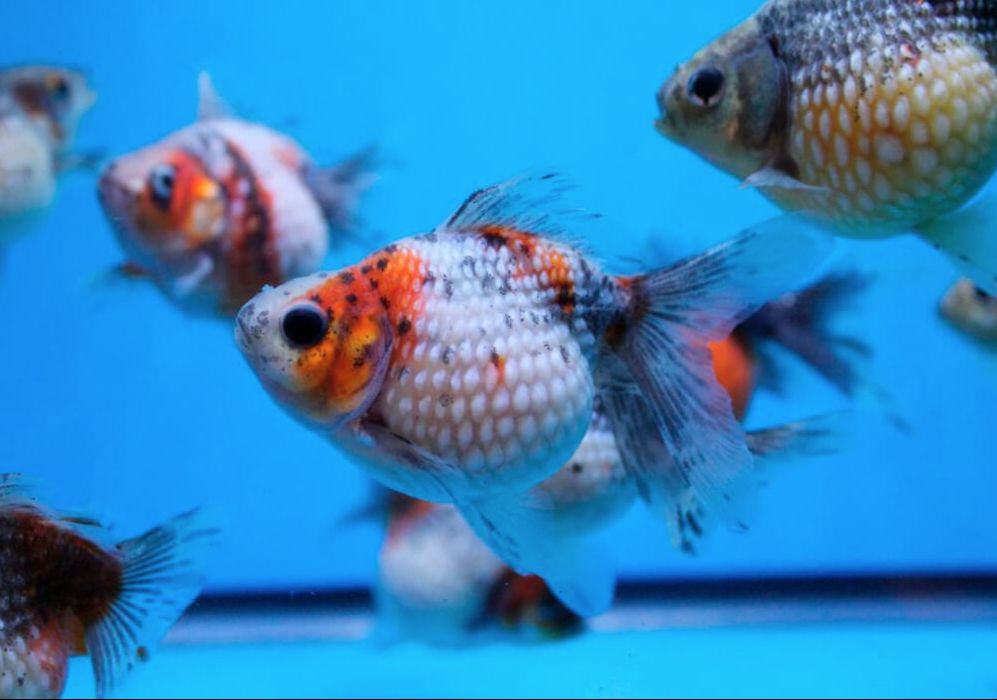
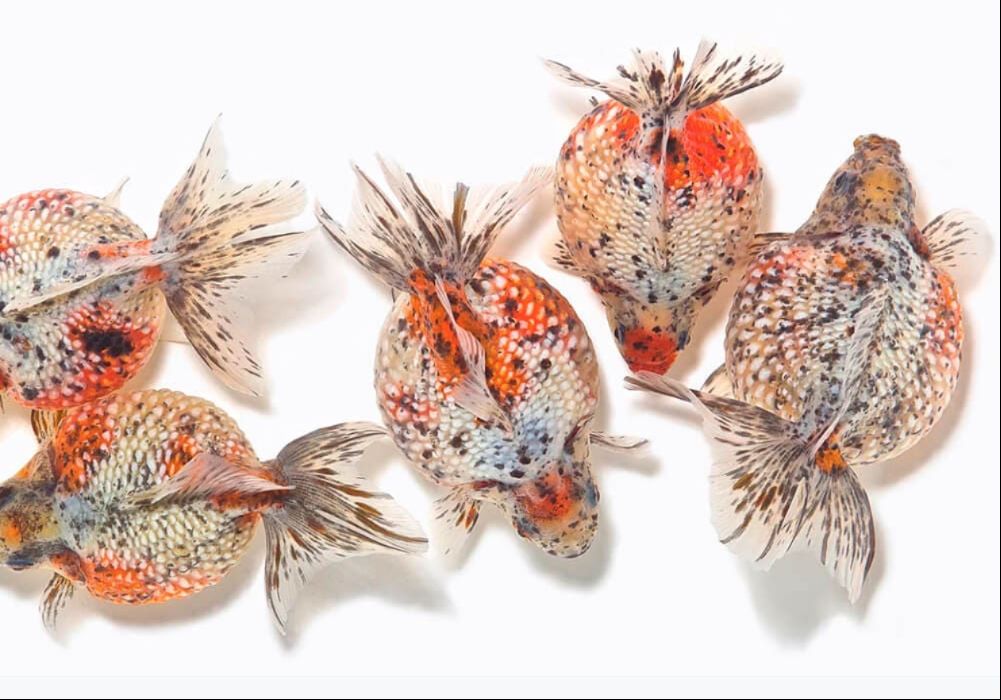
Diet
Diet Overview
The diet of pearlscale goldfish should be well-balanced to meet their nutritional needs and promote good health. As omnivores, pearlscale goldfish require a mix of both animal and plant-based foods. Ideally, their diet should contain approximately 50-70% vegetable components and 30-50% protein sources.
High-Quality Pellets or Flakes
Choose high-quality commercial pellets or flakes specifically formulated for goldfish. Look for products that offer a balanced mix of protein, carbohydrates, vitamins, and minerals. A good-quality diet is essential for supporting their growth and maintaining vibrant coloration.
Fresh or Frozen Foods
Pearlscale goldfish benefit from a variety of live and frozen foods. Options such as brine shrimp, daphnia, and tubifex provide essential proteins and nutrients. While these foods are beneficial, it’s important to include dry foods in their diet as well, ensuring a diverse nutritional profile.
Vegetables
Incorporating vegetable matter into their diet is crucial. Blanched or steamed vegetables, like peas, zucchini, spinach, and lettuce, are excellent choices. These vegetables not only aid digestion but also introduce variety, keeping your pearlscale goldfish engaged and healthy.
Feeding Frequency
Avoid overfeeding, which is a common issue with goldfish that can lead to health problems and deteriorating water quality. It’s best to feed pearlscale goldfish twice a day—once in the morning and once in the evening. Monitor portion sizes to prevent bowel obstruction, especially with protein-rich foods like bloodworms, which can cause flatulence and balance issues if overfed.
Foods to Avoid
Refrain from feeding processed human foods, as they often contain ingredients that may be harmful to goldfish. Stick to fish-specific foods to ensure their health and well-being.
Monitoring Health
Always observe your pearlscale goldfish’s condition and adjust their diet as needed. Proper nutrition plays a crucial role in their growth, coloration, and overall health. Alongside a balanced diet, maintaining good water quality and providing a suitable environment are key factors in keeping your pearlscale goldfish happy and healthy.
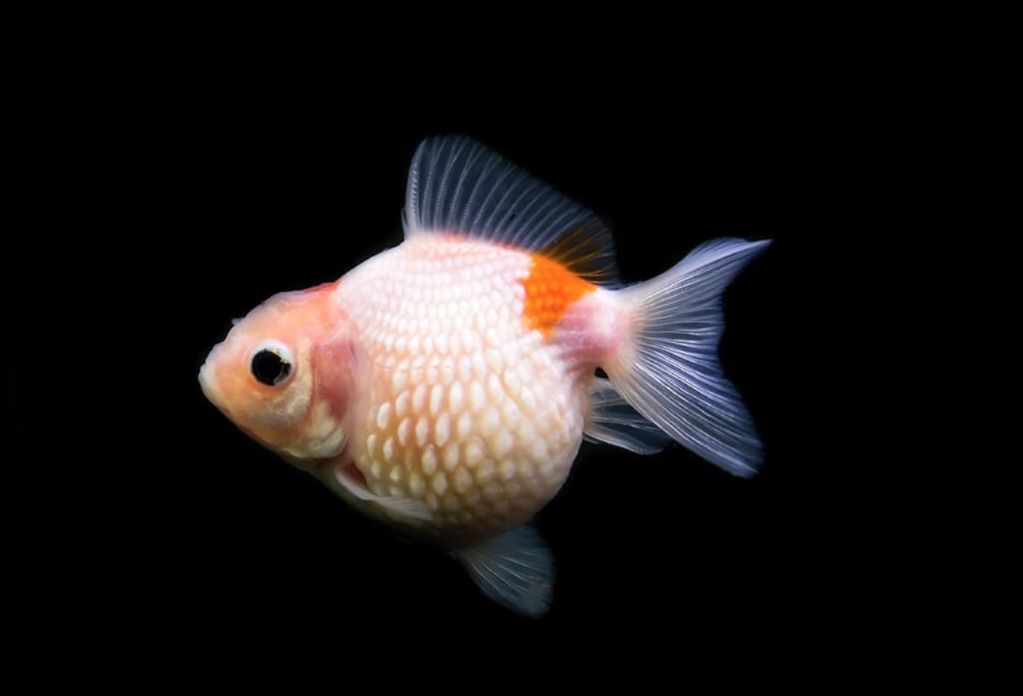
Tank mates
Is not aggressive or troublesome. However, the fact that the pearlscale goldfish is slow, has long fins and tends to live in cool water puts some limitations when choosing tank mates for it (fishes like tiger barbs – bad choice). Surely, the fish can live in a tropical fish tank, but still it feels better and more comfortable with the species of its kind – goldfish, oranda, veiltail. These fish have similar care requirements and are generally peaceful.
If you have a large enough aquarium, common goldfish can be kept with pearlscale goldfish. However, keep in mind that common goldfish grow much larger and faster than fancy goldfish, so a spacious tank is essential to accommodate their size differences.
Gender Differences: Male vs. Female
Determining the sex of adult pearlscale goldfish can be challenging, particularly when they are not in breeding condition. However, several general differences can help distinguish between males and females:
Body Shape
Males typically have a slightly slimmer and more streamlined body compared to females, particularly during the breeding season when females may appear rounder due to the presence of eggs.
Pectoral Fins
The pectoral fins, located on the sides near the gills, are usually longer and more pointed in males. In contrast, female pectoral fins tend to be shorter and rounder.
Vent Shape
The vent, situated just in front of the anal fin, differs slightly between the sexes. Males often have a more pointed vent, while females may have a rounder or slightly protruding vent.
Breeding Tubercles
During the breeding season, males may develop small white bumps called breeding tubercles on their gill covers, pectoral fins, and sometimes on their head. Females typically lack these tubercles.
Behavior
Males may become more territorial during breeding, exhibiting courtship behaviors like chasing females and nudging them. Conversely, females may become more reclusive and show signs of gravidity (carrying eggs).
It’s important to note that these differences can be subtle, and individual variations may complicate sex determination. Observing behavior during the breeding season is one of the best methods to identify potential males and females.
Breeding
Pearlscale goldfish are typically bred in farms, but you can also obtain juveniles in a home aquarium. To prepare a spawning tank, add sandy substrate and small-leaved plants. Generally, it’s best to keep one female with 2-3 males (around 2 years old) in the tank.
Pre-Spawning Conditioning
Before introducing the fish, allow them to live separately for 2-3 weeks. Maintain a water temperature in the spawning tank of around 24-26 °C. To trigger spawning, gradually increase the water temperature by 5-10 °C.
Spawning Process
As the temperature rises, males will begin to actively chase the female, who will release eggs throughout the tank. Most of the eggs will adhere to the leaves of the plants. A single female can lay about 1,000 eggs.
Post-Spawning Care
Once spawning is complete, remove the parent fish from the tank. To nurture the juveniles, provide small zooplankton as their initial food. This will support their growth and development during the crucial early stages of life.